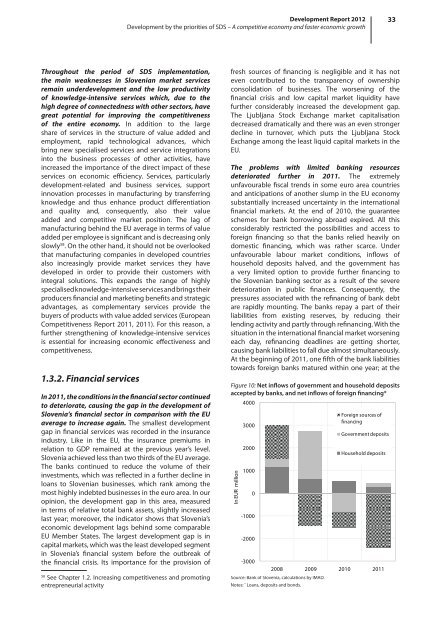development report 2012 - UMAR
development report 2012 - UMAR
development report 2012 - UMAR
Create successful ePaper yourself
Turn your PDF publications into a flip-book with our unique Google optimized e-Paper software.
Development Report <strong>2012</strong><br />
Development by the priorities of SDS – A competitive economy and faster economic growth<br />
33<br />
Throughout the period of SDS implementation,<br />
the main weaknesses in Slovenian market services<br />
remain under<strong>development</strong> and the low productivity<br />
of knowledge-intensive services which, due to the<br />
high degree of connectedness with other sectors, have<br />
great potential for improving the competitiveness<br />
of the entire economy. In addition to the large<br />
share of services in the structure of value added and<br />
employment, rapid technological advances, which<br />
bring new specialised services and service integrations<br />
into the business processes of other activities, have<br />
increased the importance of the direct impact of these<br />
services on economic efficiency. Services, particularly<br />
<strong>development</strong>-related and business services, support<br />
innovation processes in manufacturing by transferring<br />
knowledge and thus enhance product differentiation<br />
and quality and, consequently, also their value<br />
added and competitive market position. The lag of<br />
manufacturing behind the EU average in terms of value<br />
added per employee is significant and is decreasing only<br />
slowly 58 . On the other hand, it should not be overlooked<br />
that manufacturing companies in developed countries<br />
also increasingly provide market services they have<br />
developed in order to provide their customers with<br />
integral solutions. This expands the range of highly<br />
specialised knowledge-intensive services and brings their<br />
producers financial and marketing benefits and strategic<br />
advantages, as complementary services provide the<br />
buyers of products with value added services (European<br />
Competitiveness Report 2011, 2011). For this reason, a<br />
further strengthening of knowledge-intensive services<br />
is essential for increasing economic effectiveness and<br />
competitiveness.<br />
1.3.2. Financial services<br />
In 2011, the conditions in the financial sector continued<br />
to deteriorate, causing the gap in the <strong>development</strong> of<br />
Slovenia’s financial sector in comparison with the EU<br />
average to increase again. The smallest <strong>development</strong><br />
gap in financial services was recorded in the insurance<br />
industry. Like in the EU, the insurance premiums in<br />
relation to GDP remained at the previous year’s level.<br />
Slovenia achieved less than two thirds of the EU average.<br />
The banks continued to reduce the volume of their<br />
investments, which was reflected in a further decline in<br />
loans to Slovenian businesses, which rank among the<br />
most highly indebted businesses in the euro area. In our<br />
opinion, the <strong>development</strong> gap in this area, measured<br />
in terms of relative total bank assets, slightly increased<br />
last year; moreover, the indicator shows that Slovenia’s<br />
economic <strong>development</strong> lags behind some comparable<br />
EU Member States. The largest <strong>development</strong> gap is in<br />
capital markets, which was the least developed segment<br />
in Slovenia’s financial system before the outbreak of<br />
the financial crisis. Its importance for the provision of<br />
58<br />
See Chapter 1.2. Increasing competitiveness and promoting<br />
entrepreneurial activity<br />
fresh sources of financing is negligible and it has not<br />
even contributed to the transparency of ownership<br />
consolidation of businesses. The worsening of the<br />
financial crisis and low capital market liquidity have<br />
further considerably increased the <strong>development</strong> gap.<br />
The Ljubljana Stock Exchange market capitalisation<br />
decreased dramatically and there was an even stronger<br />
decline in turnover, which puts the Ljubljana Stock<br />
Exchange among the least liquid capital markets in the<br />
EU.<br />
The problems with limited banking resources<br />
deteriorated further in 2011. The extremely<br />
unfavourable fiscal trends in some euro area countries<br />
and anticipations of another slump in the EU economy<br />
substantially increased uncertainty in the international<br />
financial markets. At the end of 2010, the guarantee<br />
schemes for bank borrowing abroad expired. All this<br />
considerably restricted the possibilities and access to<br />
foreign financing so that the banks relied heavily on<br />
domestic financing, which was rather scarce. Under<br />
unfavourable labour market conditions, inflows of<br />
household deposits halved, and the government has<br />
a very limited option to provide further financing to<br />
the Slovenian banking sector as a result of the severe<br />
deterioration in public finances. Consequently, the<br />
pressures associated with the refinancing of bank debt<br />
are rapidly mounting. The banks repay a part of their<br />
liabilities from existing reserves, by reducing their<br />
lending activity and partly through refinancing. With the<br />
situation in the international financial market worsening<br />
each day, refinancing deadlines are getting shorter,<br />
causing bank liabilities to fall due almost simultaneously.<br />
At the beginning of 2011, one fifth of the bank liabilities<br />
towards foreign banks matured within one year; at the<br />
Figure 10: Net inflows of government and household deposits<br />
accepted by banks, and net inflows of foreign financing*<br />
In EUR million<br />
4000<br />
3000<br />
2000<br />
1000<br />
0<br />
-1000<br />
-2000<br />
-3000<br />
2008 2009 2010 2011<br />
Source: Bank of Slovenia, calculations by IMAD.<br />
Notes: * Loans, deposits and bonds.<br />
Foreign sources of<br />
financing<br />
Government deposits<br />
Household deposits
















